A few years ago, way back when art could still be encountered in person, Emily Bauman, Photography Curatorial Assistant at the CAM, wrote an online note about the experience of being able to handle and see up close a cyanotype by Anna Atkins, the figure who is generally credited with being the first woman photographer and the creator of the first book illustrated with photographic material. The Museum’s work, a photogram (a unique camera-less picture made by positioning an object directly on top of photosensitive paper, exposing it to light, and then processing it, typically producing a reverse image in which the object’s shadow is in white), depicts Myrrhis odorata, which is more commonly known as Sweet Cicely, in the myrrh family. It “stops me in my tracks,” Curator Bauman wrote of holding the image, which is about 9 ½ by 13 ½. “The plant’s delicate fronds against the unmistakable cyan tone are a breathtaking reminder of Atkins’s contributions to photography and science.”
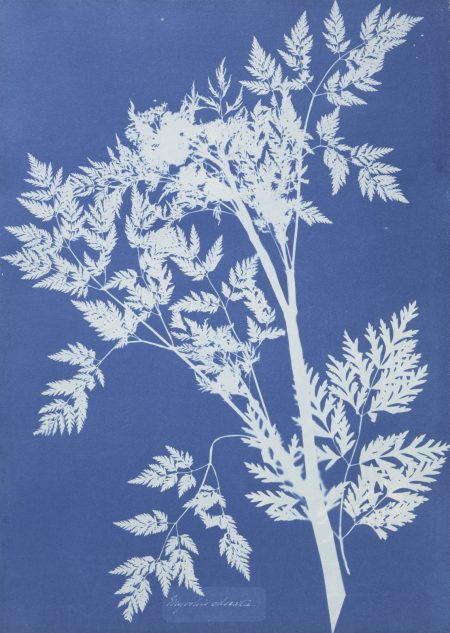
Anna Atkins was a remarkable pioneer in photography. She was born in Kent, England in 1799—the year when George Washington died, when Goya, Blake, and Constable were at the heights of their output, and Turner’s career was just under way. There was no such thing as photography. By the time Atkins died in 1871, photography was everywhere. It was a scientific tool, produced social and economic documents, and was a medium for art. Small photographic portraits of both the famous and the ordinary known as cartes de visite were exchanged (and purchased) by the thousands; virtually every living person of note was routinely photographed. Photographers traveled around the world and published their pictures of Egypt and the Middle East, China and Japan, and the American West. And their images could be protected by copyright, which meant that photographers had vested property rights in the way they saw reality. Roger Fenton had photographed the Crimean War, and Matthew Brady and his studio covered the American Civil War and published their results. Julia Cameron was one of many significant photographers whose portraits—some ordinarily domestic, most allegorical in one way or another—were clearly designed to be seen as works of art, first and foremost. All this happened within Anna Atkins’s lifetime.
She was close to where it all started. Her father, John George Children, was a friend of William Henry Fox Talbot, an inventor of one of the first viable photographic processes in the mid- to late-1830s. Children was also close to Sir John Herschel, who gave photography a language to know itself, designating, for example, a reversed photographic image as a “negative,” and coining the terms “snapshot,” and even the word “photography” itself. In 1842, Herschel invented the cyanotype, a process where paper was coated with solutions of potassium ferricyanide and ferric ammonium citrate, exposed to light, and then washed with water, leaving a rich—and durable—Prussian blue wherever the treated paper had been illuminated. The process is still used for blueprints and is widely available in museum giftshops under the name “Sunprints.” It was not merely a lensless form of photography, it was a silverless form, and generally required less complex chemistry than preparing a daguerreotype plate. Two short years later, by 1844, Anna Atkins was working on her greatest project, a guide–fully illustrated by her cyanotypes—to British Algae (think seaweed) whose production would occupy her for almost a decade.
Atkins did not have to invent the scientific part of her work: she closely followed the taxonomy of William Harvey’s Manual of British Algae (1841), but she felt that in preparing photograms of the specimens, she was relieving the artist of the burden of detail that was too important to omit but so minute as to be difficult to capture by hand. Scientific illustration was a thing she knew something about; she had done more than 250 drawings to illustrate a work on seashells that her father had written. Before she decided the project was done, she had collected or received nearly 400 different types of seaweed (a little less than half of the number Harvey had catalogued and organized) and oversaw the printing of her own work with each specimen labeled by hand on tags that were also part of the cyanotype. She seems to have envisioned an edition of around 15 copies of the whole project which required her to create nearly 6000 individual photograms of the specimens, since each photogram is a unique print. It must have been a staggering amount of work, even with the help of her best friend, Anne Dixon (a distant cousin of Jane Austen), and her servants; there is nothing mechanized about it. She sent her completed work out in small bundles to her friends and subscribers, who assembled and bound Atkins’s intermittent fascicles into books. Talbot and Herschel each had their own copies.
Though photographic historians are still debating some of the fine points of her technique—she left behind very little description of her process and work habits—it is generally thought that she set each specimen down directly on the prepared paper, labeling each by hand on paper that she had either waxed or oiled to make transparent and therefore could be printed at the same time as the specimen. She called her works cyanotype “impressions,” a word that would come to signify a great deal before the 19th century was over. Because each print is unique, there are slight differences between them as a specimen came to be placed on each new sheet of cyanotype paper; occasionally, there is evidence that specimen gave out through constant handling and had to be replaced with another one. Whatever skills were involved in creating the volumes, surely Atkins must have had a genius for the organization of complex tasks and a single-minded energy to see the thing through.
And then, at some point, she stopped. Her father died in 1852, and Atkins seemed to have decided to wind the project down at around the same time. She moved on to make photograms of feathers and lace, and an additional botanical project of some substance, Cyanotypes of British and Foreign Ferns, which seems more a compendium for the artist’s and an audience’s pleasure than a attempt at a thorough taxonomy. She gathered about 160 specimens for this collection, which can be dated to around 1853, and worked in addition on images of a variety of herbs, plants, and flowers.
It would not have been thought untoward for a woman—especially one of independent means—to be engaged in making art. Drawing was considered a valuable accomplishment in a young lady at a time when chemistry, for example, was not. Besides, it is argued by cultural historians that the 19th century believed that engaging with natural forms was an appropriate activity for women and might enhance their appreciation for—and display of—feminine beauty. In addition, daughters were thought to be natural persons to aid a fathers’ work, a legitimate and laudable way for the parent to accomplish more. (In the culture of the times, the model would have been Milton’s daughters.) Atkins would have been thought an amateur, but then again, her father was barely more than that. In fields like science, it would have been less clear than it is today what was the opposite of an amateur. After all, John James Audubon and Ben Franklin were both, technically, amateurs in their fields, though highly lauded ones. Credentialing was more limited in the mid-19th century, and expertise more likely to be granted a person according to the networks of the people they knew personally. In many ways, amateur status chiefly indicates a different relationship to potential markets for one’s work and ideas. Natural history was in many ways an ideal sphere for the upper middle class, requiring mostly time to gather specimens and spaces to sort them out. Curator Hope Saska says of Atkins that she fulfilled the “amateur ideal.”
It is a purposeless question to ask whether Atkins’s work more properly comes under the heading of science or of art. Certainly in the form’s earliest years, any photograph called upon the resources of both. Atkins would have been unlikely to have claimed originality for her work on either count. When it came to science, in an age of naming, the nomenclature was not her own. On the other hand, insofar as good science required careful and thoughtful collecting of specimens, a field-oriented connoisseurship was as significant and consequential as being able to distinguish between, say, the various states of a Rembrandt etching. As the composer and designer of her book, Atkins was also entering into a centuries’-long debate inherent to natural history: What does a thing look like? How should it be represented? This raised the question of how a two-dimensional illustration could best hope to capture a three- or, more accurately, a four-dimensional object, a living thing with presences both in space and across time. Do you try to represent what any and all of a particular thing looked like, or what one particular example looked like at one moment of its life? The first is inherently untrue to the original because it is highly idealized. The second is inherently untrue to the species because only one particular example looked that way, and others may vary.
The argument in favor of the first is that every specimen looks more or less this way, but no individual specimen ever looked exactly that way. The argument for the second is that at least we can say that one exemplar in the world actually and entirely looked like this. All Honey Crisp apples look more or less the same, but most people spent time at the grocery store—back in the day—making the choice of one exemplum over another. If you’ve ever been birding and needed to identify a species that was new to you, you’ve experienced the difference between, say, Roger Tory Peterson’s amazing generalizations of birds and the Audubon society’s intrinsically more accurate photographs of actual birds. Or you might think of the differences between the snaky and detailed maps of transit routes from the 1950s and 60s compared to the highly schematized, red-line/blue-line maps of today. Sometimes you crave your Aristotle; sometimes you need your Plato.

There is a long tradition of seeing this debate embodied in the herbal tradition through which the natural world was taxonomized for its audiences from the late medieval period onward. What should a specimen look like? Some of the most elegant early herbals could not possibly have been of use to collectors in the fields or makers of tinctures because their renditions of so many plants looked the same. On the other hand, the herbals that consist of actual portraits of individual specimens may be equally baffling, exquisitely capturing, say, an exemplar as it begins to wilt on the shelf, or one where natural variance includes branches with five leaves and branches with six. Does a rose leaf look more or less like itself when it has insect damage on it?
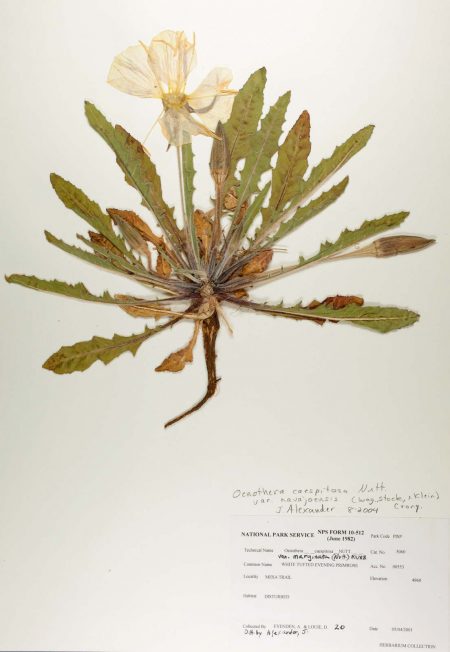
By the mid-19th century, things had come a long way in the name of better science. The romantic celebration of subjectivity was busily engendering its own correctives. If the perfect accuracy of drawings was too likely to succumb to the perceptions and dispositions (and skills) of individual artists, then do away with the person doing the rendering. The 19th century was the great period for starting collections of herbaria, where actual dried specimens of plants would be mounted systematically in books. The specimens still had to be selected with care and thoughtfulness, and they were likely to be arranged on their page so as to show all the relevant details—roots and flowers as well as stems and leaves. Since there was a steady need to disseminate information as well as collect and organize it, by the 1850s, some books were being produced by the experimental technique known as “nature printing,” where actual specimens would be pressed into soft metal which was then faced with a much harder metal so that it could go through a printing press. The image of the plant you see on the page was literally made by the plant as it was found in the field. These images are delicate and beautiful and seem an enhancement of nature while still assuring accuracy. Artistic means were put to use in support of scientific ends. For the 19th century, we can collapse the science vs. art argument by seeing the new technologies for naturalist illustration as a prediction of the Bauhaus guideline: form follows function. The form will be beautiful so long as it is true in representing its function.
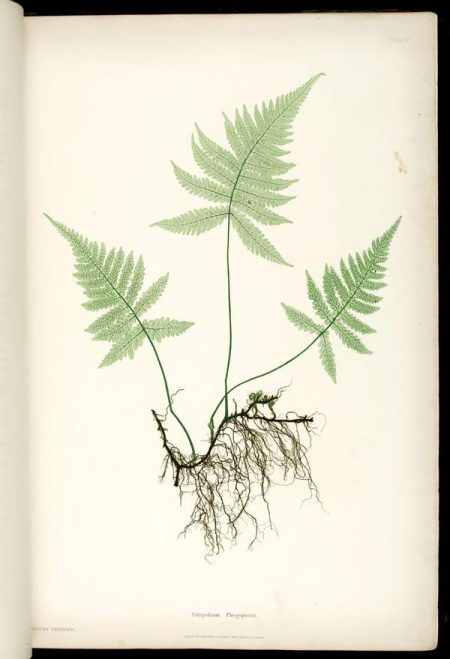
In each medium, color is necessarily sacrificed. In herbaria, the mounted specimens are chiefly shades of brown; in nature printing (as with other deluxe editions), the color scheme is limited to the number of times an etching plate will be passed through a press. And of course, in cyanotypes, the color we encounter on the page is either Prussian blue or bone white, as surely as a digital bit of information is either a one or a zero. Some commentary on Atkins’s work treasures the richness of the blue, finding in it a happy echo of the ocean from which the seaweed was plucked; this is a less effective argument when it comes to the ferns. In many ways, her cyanotypes are as schematic as a woodcut in a medieval herbal. They are as flat as stencils, invoking the sorts of pleasures that a pouchoir would bring in the late 19th-early 20th centuries. They are, after all, literally images of shadows, and resist any desire we might have to see an internal essence to a thing. They are as ghostly in their own way as the herbaria; a live specimen was once here, but now it’s gone. A photogram is not a picture of an object in space, but a marker, a memorial, to where an object once was. The shadow has been made permanent.

On the other hand, though they are camera-less images, they are capable of being highly pictorial. Adapting the specimen to the page requires design and composition. If the technology of the photogram takes out some of the artist’s willfulness, the need for efficient design puts it back in. Some of Atkins’s work is clearly connected the mid-19th century appetite for the domestic picturesque. She designed her title pages to imitate the covers of certain sorts of books and magazines, where the plant material is reduced to decorative ornamentation. Atkins’s work which has come to be the most highly prized sheds those confines. They don’t merely represent a plant for purposes of identification, but revel in the forms and shapes of nature. The work sometimes seems driven by the scientific and perhaps spiritual conviction that nature repeats itself in different forms. “Chordata flagelliformis” is a picture of a seaweed that resembles a leafless bush or a compound burst of lightning bursting through a twilight sky. “Delessaria sanguinea” looks like lobeless leaves on a forest floor, or even a profile of the trees from which they came. “Papaver rhoeas” is the common poppy, here in all its sensual, tangled glory as if it had been drawn by William Wallace Denslow for the first edition of The Wizard of Oz, though since it’s hard to make out the borders of the individual petals, they could be a sort of water lily.

The CAM’s Atkins is more artless than some of her most extravagant work. In contrast to the poppy or the Chordata flagellaformis, it may seem grossly ordinary. “Myrrhis Odorata” is a picture of a plant in the parsley family, and therefore related to carrots and chervil. It is widely cultivated as an herb with a taste like anise. By some accounts, its leaves are as sweet as candy. It has modest medical uses and, according to A Modern Herbal, published by a Mrs. Maud Grieve in 1931, it is “a valuable tonic for girls from 15 to 18 years of age.” The plant tends to run very tall, which perhaps explains why the picture only seems like a cutting from the top, leaving out the often-present root system. It has flowers like Queen Anne’s Lace, though as with almost all photograms, the flowers are the hardest thing to capture. They are not as flat as leaves and easily crushed, losing visual definition. There is a white blur over the center of the picture that may be a set of blossoms. Much thinner stems with fern-like leaves–which presumably explains its immediate interest to Anna Atkins—branch off a thick central stem. The leaves accelerate to delicacy very quickly. One thin stem has been bent down to fill the space better; a separate, detached stem has been brought in to fill out the composition in the lower right corner. It must have been set down on top of the central stem, because it didn’t lie flat against the cyanotype paper; it is a little bit blurred, giving depth to the image. Is it too much to imagine the licorice smell or to hear the snip of the shears? The drama this picture illustrates certainly includes the care required to get a perfect specimen, and to place it such a way as to let the plainness of a thing—with the aid of photography as the new medium and technology—do the talking for itself.
The photogram as art form came to be important to the early modernists. In the years immediately after World War I, Christian Schad made photograms from the detritus in his pockets and his studio, producing photographic equivalents to the early collages of Braque, Picasso and Schwitters; they came to be known as “Schadographs.” Shortly afterwards, the form interested Man Ray and Laszlo Maholy-Nagy, who added to its development by using three-dimensional objects as well as flat ones, and by moving the light source while exposing the paper, softening the silhouette and stencil-like quality of the medium. But its half-century old connection to women’s engagement with botanical forms had never fully disappeared. An album of 19 cyanotype photograms survives from the hand of one Florence Mapes, who labeled one of her pictures “from our yard.” AtlasObscura reports a pair of albums made by Helen Chase Gage in 1929-30 when she was around twelve years old, pairing dozens of cyanotype photograms with the specimens she used as sources mounted on the opposite page, combining blueprint and herbaria.
Photograms continue to be of interest to artists with any number of goals, including Thomas Ruff, whose monumental computer-generated artificial photograms were shown not long ago at the CAC. But I’m particularly interested in the ways that the original photogram techniques have been modified and adapted. The more our cameras enable us to speed up all photographic processes, the more a counter movement seems to emerge that desires to slow things down, as John Coffer argued in Photography’s Antiquarian Avant-Garde (2002). The list of artists who have found new life in the photogram in the early 21st century is surprisingly extensive, and I will only mention a few. Justine Varga and Alison Rossiter produce powerful abstract works by making photograms that eliminate the target object altogether and manipulate instead the film or working, as Rossiter does, with the accidents made possible by developing long-expired printing papers. Meghann Riepenhoff (who also works in cyanoype) and Susan Derges return to the tradition of using the photogram to illustrate nature, but they do not illustrate it at all; each of them allows nature to work on the photographic paper directly—Derges, for example, by placing the paper in moving water and shining a flashlight down onto it, or sometimes, just letting the sheet get exposed by the light of a particularly bright moon.
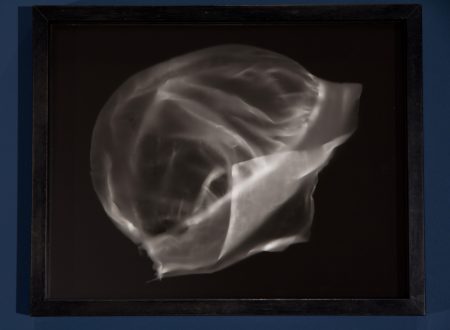
I want to conclude by briefly mentioning three artists whose work in the photogram tradition takes us back to some of the gender issues raised implicitly in Atkins’s work: Nancy Wilson-Pajc (who also works in cyanotype), Anne Ferran, and Greater Cincinnati’s own Anita Douthat. Each of these artists does photograms of clothing, typically but not exclusively women’s clothing. In exposing the printing paper, they tend to value the possibility that some parts of a woman’s costume are going to be transparent and some opaque. Ferran’s and Douthat’s work in particular are both formal—it partly looks like the costumes have been hung up for display—and informal—it partly looks as if they have just been shed and dropped on the floor. The pictures are a little like x-rays with the bodies missing, which of course makes the bodies all the more present in our mind. It is hard, for example, to see Ferran’s exquisite and delicate “Baby’s Bonnet” (1998) without wondering where the baby is now. In an age where we are familiar with archives of looted clothes from prisoners and refugees, we wonder whether this baby has merely outgrown a loved hat that a parent has held onto, or whether it shows us the assassination of childhood.
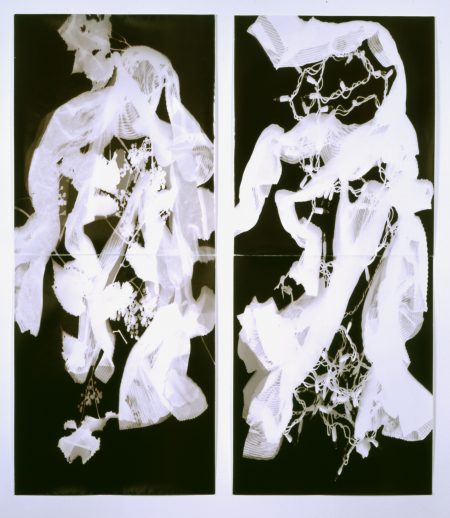
Douthat has put together an extraordinary body of work over the decades in four separate shows since 1993 that featured photograms of clothes. In a series from 2007 that she has called “Alterations” (which was shown at the Weston Gallery), she has literally deconstructed more elaborate garments down to their basic elements. The clothes are rearranged to keep the human shape in mind, only the bodies have slipped away; it is as if they have shed the garments like a skin they’ve grown out of. “Alterations” (2007) pairs 2 such figures, perhaps made from the same set of fragments. They are posed dramatically–dancing, I might have thought, or perhaps orating, or possibly remonstrating. They are as light as a second skin, but are under the control of gravity, falling with effortless delicacy. On the one hand, the clothes are lovely, showing detailing and the fine ways that the original makers and designers allowed cloth to take human form without smothering it. On the other hand, they are elegies of decay. They celebrate the artifice of clothing but also the anatomy that was once concealed beneath it.
As for the organic material that the bodies might have been made of, in one case, it has been replaced by a string of Christmas lights, which look like an absurd but effective mimicking of the circulatory system, but which also seem a little like elaborate shackles. In the other one of the pair, the organic material consists of leaves that look like torn fabric—or possibly vice versa—and sprigs of flowers. It brings us back, with a century and a half of differences, to Atkins’s world, where specimens are both signs of life and signs of imminent desiccation, and where the outline of things makes us ponder the more fully physical things that used to be there.